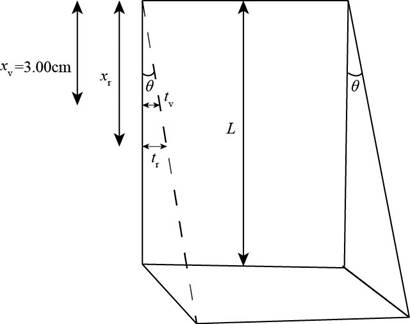
Concept explainers
Figure CQ37.2 shows an unbroken soap film in a circular frame. The film thickness increases from lop to bottom, slowly at first and then rapidly. As a simpler model, consider a soap film (n = 1.33) contained within a rectangular wire frame. The frame is held vertically so that the film drains downward and forms a wedge with flat faces. The thickness of the film at the top is essentially zero. The film is viewed in reflected white light with near-normal incidence, and the first violet (λ = 420 nm) interference band is observed 3.00 cm from the top edge of the film, (a) Locate the first red (λ = 680 nm) interference band, (b) Determine the film thickness at the positions of the violet and red bands, (c) What is the wedge angle of the film?
(a)
The position of the first red interference band.
Answer to Problem 37.70AP
The position of the first red interference band is
Explanation of Solution
Given info: The index of refraction of the soap film is
The diagram of thin film in rectangular wire frame is,

Figure (1)
From figure (1), the formula of tangent of angle is,
Here,
Rearrange the above equation for
The condition for constructive interference for red band in a thin soap film is,
Here,
The condition for constructive interference for violet in a thin soap film is,
Here,
Divide equation (3) by (4) on both sides.
Substitute
Substitute
Substitute
Conclusion:
Therefore, the position of the first red interference band is
(b)
The film thickness at the position of red and violet bands.
Answer to Problem 37.70AP
The film thickness at the position of red band is
Explanation of Solution
Given info: The index of refraction of the soap film is
From equation (3), the condition for constructive interference is,
Substitute
From equation (4), the condition for constructive interference is,
Substitute
Conclusion:
Therefore, the film thickness at the position of red band is
(c)
The wedge angle of the film.
Answer to Problem 37.70AP
The wedge angle of the film is
Explanation of Solution
Given info: The index of refraction of the soap film is
From figure (1), the formula of tangent of angle is,
Substitute
Conclusion:
Therefore, the wedge angle of the film is
Want to see more full solutions like this?
Chapter 37 Solutions
Physics for Scientists and Engineers, Technology Update (No access codes included)
- A beam of 580-nm light passes through two closely spaced glass plates at close to normal incidence as shown in Figure P27.23. For what minimum nonzero value of the plate separation d is the transmitted light bright?arrow_forwardIn the double-slit arrangement of Figure P36.13, d = 0.150 mm, L = 140 cm, = 643 nm. and y = 1.80 cm. (a) What is the path difference for the rays from the two slits arriving at P? (b) Express this path difference in terms of . (c) Does P correspond to a maximum, a minimum, or an intermediate condition? Give evidence for your answer. Figure P36.13arrow_forwardFigure P36.53 shows two thin glass plates separated by a wire with a square cross section of side length w, forming an air wedge between the plates. What is the edge length w of the wire if 42 dark fringes are observed from above when 589-nm light strikes the wedge at normal incidence? FIGURE P36.53arrow_forward
 Physics for Scientists and Engineers: Foundations...PhysicsISBN:9781133939146Author:Katz, Debora M.Publisher:Cengage Learning
Physics for Scientists and Engineers: Foundations...PhysicsISBN:9781133939146Author:Katz, Debora M.Publisher:Cengage Learning Principles of Physics: A Calculus-Based TextPhysicsISBN:9781133104261Author:Raymond A. Serway, John W. JewettPublisher:Cengage Learning
Principles of Physics: A Calculus-Based TextPhysicsISBN:9781133104261Author:Raymond A. Serway, John W. JewettPublisher:Cengage Learning Physics for Scientists and EngineersPhysicsISBN:9781337553278Author:Raymond A. Serway, John W. JewettPublisher:Cengage Learning
Physics for Scientists and EngineersPhysicsISBN:9781337553278Author:Raymond A. Serway, John W. JewettPublisher:Cengage Learning Physics for Scientists and Engineers with Modern ...PhysicsISBN:9781337553292Author:Raymond A. Serway, John W. JewettPublisher:Cengage Learning
Physics for Scientists and Engineers with Modern ...PhysicsISBN:9781337553292Author:Raymond A. Serway, John W. JewettPublisher:Cengage Learning



